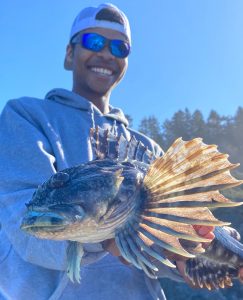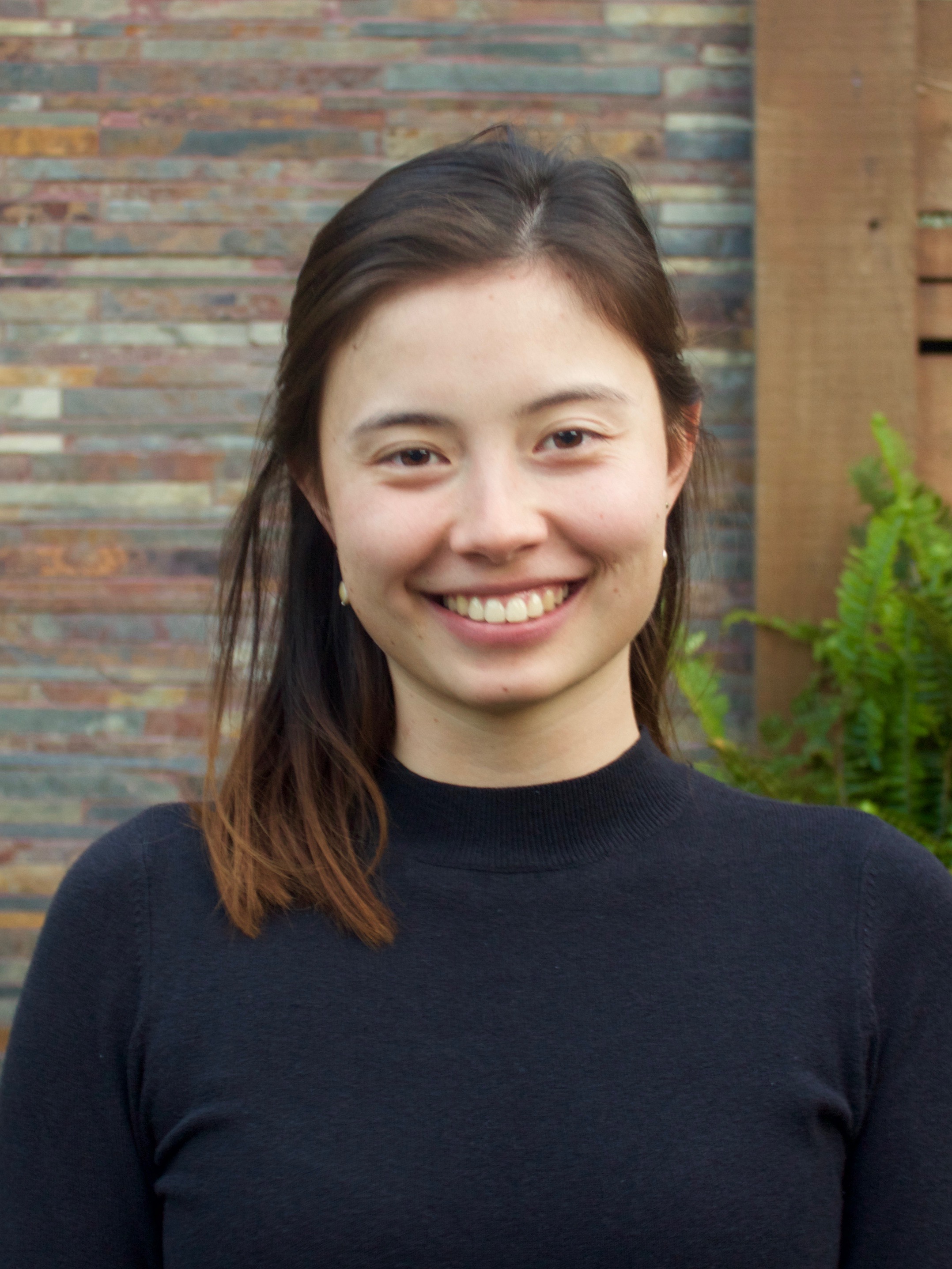Overview
SIMoN is an integrated, long-term program that seeks to identify and understand changes within sanctuaries managed by the Office of National Marine Sanctuaries. SIMoN provides resource managers with the information needed for effective decision-making and promotes a basic understanding of the complex and unique marine processes within the California Current ecosystem. By gathering summary metadata from on-going, recently completed and historic monitoring and research projects within sanctuaries, SIMoN facilitates the critical but often overlooked communication between researchers, resource managers, educators and the public.
The SIMoN web site (and associated database) provides sanctuary staff, collaborative partners, agencies, and the public a powerful tool to quickly access summary information on hundreds of monitoring and research programs that occur within sanctuaries. In addition, SIMoN provides digital images, maps and species-level natural history information. The Photo Library is constantly accessed for high-quality, public-domain images of the organisms and resources found within west coast national marine sanctuaries, and the Species Database serves as an online field guide.
SIMoN Goals
- Maintain a database that tracks current and historic monitoring programs and research projects relevant to sanctuary management
- Integrate existing monitoring programs conducted in west coast regional sanctuaries to provide a synoptic overview of the marine ecosystem
- Initiate basic surveys or characterizations of all sanctuary habitats and regions
- Establish a series of long-term monitoring efforts to fill in critical information gaps
- Initiate specific, question-driven monitoring efforts with fixed durations
- Provide timely and pertinent information to managers and decision makers, the research community, and the general public via a web site and other venues
SIMoN exists due to the efforts and contributions of hundreds of partners and collaborators, including Federal and state agencies, universities and other academic institutions, and numerous non-governmental organizations.
Contributors
SIMoN is a collaborative project that partners sanctuary staff with other agencies, academic institutions, and NGOs. Many members of the MBNMS staff have contributed, as have NOAA and Sea Grant fellows and interns. Below are profiles of the current members of the SIMoN team.
Besides a core of three sanctuary staff (DeVogelaere, Lonhart and King), there are several other members of the extended SIMoN family. Since 2002 this has included volunteers, interns, long-term and short-term contractors, as well as staff located at other sanctuaries. Many of the major accomplishments by SIMoN were the result of a group effort with these collaborators and partners (see partial list below).
SIMoN Contributors
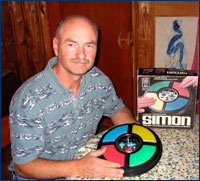
Andrew DeVogelaere, Ph.D.
SIMoN Director
(831) 647-4213
andrew.devogelaere@noaa.gov
Dr. DeVogelaere oversees the Sanctuary’s Research Program and leads the the Sanctuary Integrated Monitoring Network (SIMoN) team. His job includes facilitating collaboration among over 20 research institutions in the region, providing technical information to decision makers and the Sanctuary staff, and initiating research on resource management issues.
He has been directly involved in a wide variety of research projects in habitats from the deep sea to estuaries. Dr. DeVogelaere’s past work experience includes being an elected official as Commissioner for the Moss Landing Harbor District and Research Coordinator for the Elkhorn Slough National Estuarine Research Reserve. He earned a Bachelor of Arts degree in Biology from the University of California at Berkeley, a Master of Science degree in Marine Science from Moss Landing Marine Laboratories and a Doctorate degree in Biology from the University of California at Santa Cruz.
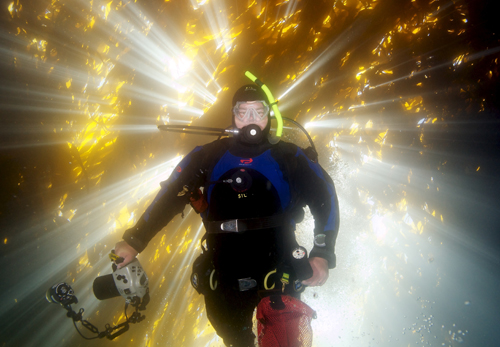
Steve I. Lonhart, Ph.D.
SIMoN Senior Scientist
(831) 420-3661
steve.lonhart@noaa.gov
Dr. Lonhart has worked as a marine ecologist for MBNMS since 2002 and is a Research Specialist and Unit Diving Supervisor. Steve is responsible for maintaining research and monitoring programs and implementing scientific goals to integrate existing monitoring programs within the sanctuary; supporting research and monitoring programs that address important resource management issues; and disseminating information to resource managers, researchers, educators, and the general public. Steve collaborates and partners with multiple research and monitoring programs, spanning estuarine, rocky intertidal, and subtidal nearshore habitats.
Steve has biology degrees from UCLA (BS 1990), California State University Long Beach (MS 1996), and UC Santa Cruz (PhD 2001). Though he has several interests in marine ecology, his scientific research has focused on invasion biology, kelp forest ecology, range shift ecology, biogeography, and marine invertebrate natural history. Lonhart CV here.
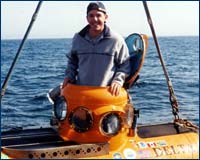
Chad King, M.S.
SIMoN GIS and Data Specialist
(831) 647-4248
chad.king@noaa.gov
Chad is responsible for the collection, analyses, and dissemination of spatial data for SIMoN. These data help integrate past and present monitoring programs within the Sanctuary, provide resource managers with decision making tools, and will be available to researchers, educators, students, and the general public. Chad actively participates in the field with Sanctuary and SIMoN research teams.
Chad earned a Bachelor of Science degree in Marine Biology at the University of California, Santa Cruz, and a Master of Science degree in Marine Science from Moss Landing Marine Laboratories. His research focused on how the genetics of an algal symbiont and substratum instability affect the reproductive behavior of a sea anemone from the Gulf of Mexico. Previous research focused on kelp forest ecology. Prior to SIMoN, he was with the California Department of Fish and Game as a GIS Analyst. His work there primarily addressed spatial analyses of commercial fishing pressure and the correlation between rugosity of the sea floor and rockfish abundance. This included the coordination of high-resolution map development of the sea floor, GPS navigation, and rockfish counts using SCUBA.
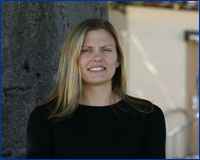
Jennifer Brown, Ph.D.
SIMoN Ecosystem Scientist
(415) 310-6764
jennifer.brown@noaa.gov
As the Ecosystem Scientist for the Sanctuary Integrated Monitoring Network (SIMoN), Jennifer Brown is responsible for developing and coordinating ecosystem assessments at both local and regional levels. These ecosystem models and condition reports help address resource management needs for integrated monitoring information. Additionally, Jennifer provides science support for the Marine Protected Areas MBNMS Action Plan through the development of data summaries and resource assessments.
Jennifer has a Bachelor of Science Degree in Biology from University of California at Los Angeles and a Doctorate Degree in Ecology and Evolutionary Biology from the University of California at Santa Cruz. Her research focused on evaluating the relative value of nearshore ecosystems at nursery grounds for juvenile flatfish. Other past projects focused on the Monterey Bay area include: 1) A Review of Marine Zones in the Monterey Bay National Marine Sanctuary which is part of the National Marine Sanctuary Conservation Series, 2) A plan for monitoring the fish assemblage in Elkhorn Slough prepared for the Elkhorn Slough National Research Reserve, and 3) a review of the Special Status Species that reside in or transit through the Monterey Bay National Marine Sanctuary.
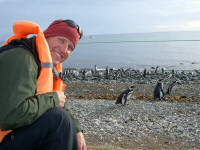
Scott Chapman
SIMoN Web Developer
scott.chapman@noaa.gov
Scott works with SIMoN’s technical infrastructure. Using cutting-edge web technology, he is responsible for building and maintaining the SIMoN website, interfaces used to enter and manage monitoring information, and the SIMoN database.
Upon earning a Bachelor of Science in Electrical Engineering from San Jose State University, Scott worked as a software and quality assurance engineer for various software companies in Silicon Valley. Much of his development work utilized the latest web technologies to deliver interactive and dynamic content over the internet.
Scott is also a SCUBA instructor and has an MA in Exercise Physiology. Along with his part-time work for SIMoN, Scott is currently a full-time Dive Officer at the Monterey Bay Aquarium.
Robert Mazurek
California Marine Sanctuary Foundation
The California Marine Sanctuary Foundation (CMSF) has been and continues to be a strong supporter and partner with the SIMoN program since its inception is 2002. The collective effort of all the various contributors has made this program invaluable to a broad base of beneficiaries, including scientists, policymakers, the general public, and many others. CMSF congratulates the SIMoN team on nearly 20 years of open collaboration and information sharing.
NOAA Scholars
2022 Vanessa ZoBell, NOA Nancy Foster Scholar
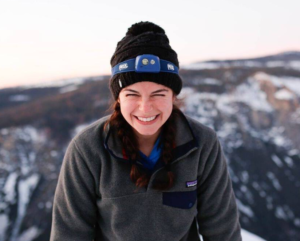 Vanessa ZoBell pursued her B.S. at UC Davis in Wildlife, Fish, and Conservation Biology and her M.S. in Marine Biology at Scripps Institution of Oceanography. She is now continuing at Scripps for her Ph.D. in Biological Oceanography at the Scripps Institution of Oceanography in the Whale Acoustic Lab with Dr. John Hildebrand. As a Nancy Foster Scholar, she works with Channel Islands National Marine Sanctuary to investigate how to mitigate chronic ocean noise from anthropogenic stressors, such as container ships, that transit through the sanctuary. Vanessa hopes to give policy makers the information needed to decrease human impacts within the sanctuary. Vanessa also collaborated with Monterey Bay National Marine Sanctuary as a Nancy Foster Scholar to investigate the spatiotemporal trends of blue and fin whales within the sanctuary. After completing her PhD, Vanessa hopes to continue researching anthropogenic threats in the ocean to identify solutions for coexistence between animals, ecosystems, and humans.
Vanessa ZoBell pursued her B.S. at UC Davis in Wildlife, Fish, and Conservation Biology and her M.S. in Marine Biology at Scripps Institution of Oceanography. She is now continuing at Scripps for her Ph.D. in Biological Oceanography at the Scripps Institution of Oceanography in the Whale Acoustic Lab with Dr. John Hildebrand. As a Nancy Foster Scholar, she works with Channel Islands National Marine Sanctuary to investigate how to mitigate chronic ocean noise from anthropogenic stressors, such as container ships, that transit through the sanctuary. Vanessa hopes to give policy makers the information needed to decrease human impacts within the sanctuary. Vanessa also collaborated with Monterey Bay National Marine Sanctuary as a Nancy Foster Scholar to investigate the spatiotemporal trends of blue and fin whales within the sanctuary. After completing her PhD, Vanessa hopes to continue researching anthropogenic threats in the ocean to identify solutions for coexistence between animals, ecosystems, and humans.
2022 Travis Leggett, NOAA Experiential Research & Training Opportunities
Travis graduated in 2018 with a B.S. in Marine Science from CSUMB, where he studied marine organism distribution, MPA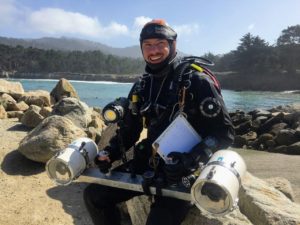 effectiveness, and stressor-induced grazer-kelp relationships. After graduation, he worked with CSUMB studying the ecological impact of deep-sea cables. He is intrigued by the subtidal community and exploring the boundaries of what scientific SCUBA techniques can accomplish. As a graduate student at MLML (advised by Dr. James Lindholm, CSUMB and co-advised by Dr. Amanda Kahn, MLML), he continues to leverage SCUBA as a tool to study the distribution of epifaunal invertebrates and kelp refuges in Carmel Bay. Travis is interested in utilizing underwater stereo video as a novel approach to determining the mechanisms and influencers associated with kelp deforestation. In summer 2022 Travis will work with Dr. Steve Lonhart to test the precision of photo quadrat sampling techniques by varying quadrat size, and both distance and angle of the camera system.
effectiveness, and stressor-induced grazer-kelp relationships. After graduation, he worked with CSUMB studying the ecological impact of deep-sea cables. He is intrigued by the subtidal community and exploring the boundaries of what scientific SCUBA techniques can accomplish. As a graduate student at MLML (advised by Dr. James Lindholm, CSUMB and co-advised by Dr. Amanda Kahn, MLML), he continues to leverage SCUBA as a tool to study the distribution of epifaunal invertebrates and kelp refuges in Carmel Bay. Travis is interested in utilizing underwater stereo video as a novel approach to determining the mechanisms and influencers associated with kelp deforestation. In summer 2022 Travis will work with Dr. Steve Lonhart to test the precision of photo quadrat sampling techniques by varying quadrat size, and both distance and angle of the camera system.
2022 Audrey Sarin, Ernest F. Hollings Undergraduate Scholarship
Audrey (she/her) is an undergraduate student at California Polytechnic State University, San Luis Obispo working towards a B.S. in Marine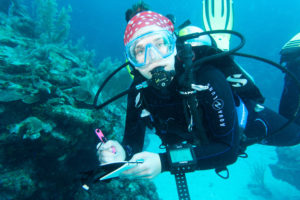 Sciences. Audrey’s prior research focuses on the effects of gametic exposure to microplastics on the fertilization and development of sea urchin embryos. She also participates in monitoring on the recovery of the Pismo clam population in Central California. Audrey is thrilled to work on monitoring efforts within Monterey Bay National Marine Sanctuary in Summer 2022. Under the guidance of Dr. Steve Lonhart, she will evaluate sea urchin and kelp populations to determine the efficacy of new regulations within the sanctuary. Audrey looks forward to building on her scientific diving experience and expanding the scope of her research. She knows this internship will support her on her trajectory to pursue a doctoral degree in marine sciences.
Sciences. Audrey’s prior research focuses on the effects of gametic exposure to microplastics on the fertilization and development of sea urchin embryos. She also participates in monitoring on the recovery of the Pismo clam population in Central California. Audrey is thrilled to work on monitoring efforts within Monterey Bay National Marine Sanctuary in Summer 2022. Under the guidance of Dr. Steve Lonhart, she will evaluate sea urchin and kelp populations to determine the efficacy of new regulations within the sanctuary. Audrey looks forward to building on her scientific diving experience and expanding the scope of her research. She knows this internship will support her on her trajectory to pursue a doctoral degree in marine sciences.
2022 Gracia Rojas, EPP Undergraduate Scholarship
Gracia is a current undergraduate student at The College of the Florida Keys (CFK), pursuing a Bachelors of Marine Resource Management. Gracia’s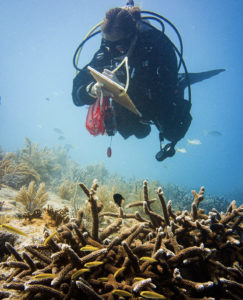 prior research experience includes land–based coral restoration with Mote Marine Laboratory, focusing on improving the health of Caribbean corals by reducing underlying pressures posed within an aquaculture-based system. In summer 2021 she worked with Florida Keys National Marine Sanctuary, where she assisted the development of several projects, including Monitoring and Maintenance Protocols for the Piloting program at CFK, which allowed CFK students to participate in local coral restoration efforts.
prior research experience includes land–based coral restoration with Mote Marine Laboratory, focusing on improving the health of Caribbean corals by reducing underlying pressures posed within an aquaculture-based system. In summer 2021 she worked with Florida Keys National Marine Sanctuary, where she assisted the development of several projects, including Monitoring and Maintenance Protocols for the Piloting program at CFK, which allowed CFK students to participate in local coral restoration efforts.
In Summer 2022, Gracia will work with Dr. Steve Lonhart to capture underwater imagery utilizing a wide-angle camera and tripod to create 360° views. Gracia’s work will display the underwater ecosystems of the sanctuary to non-divers and divers alike. Gracia is an avid scuba diver and underwater photographer, and this internship will continue to build on her underwater research experiences and passion for marine ecosystems, with the potential to pursue a career with NOAA.
2022 Sofia Gluskin, Ernest F. Hollings Undergraduate Scholarship
Sofia is a rising senior at the University of South Florida in Tampa, Florida, pursuing a B.S. in Biology with a concentration in Ecology and Evolution and a minor in Psychology. In Summer 2022, she will work as an intern with Dr. Alison Haupt at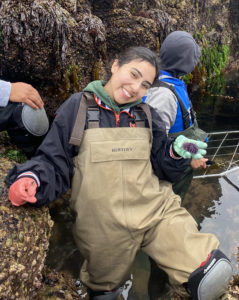 CSUMB on the Haupt Lab’s intertidal sea urchin reproduction and recruitment project, as well as under the guidance of Dr. Steve Lonhart at Monterey Bay National Marine Sanctuary. During her internship, she will help conduct intertidal field research at various sites around the Monterey Peninsula to survey the population dynamics of sea urchins, sea stars, and abalone with an overarching goal of informing the restoration and recovery of central coast kelp forests. Furthermore, 20-30 urchins will be collected from each site and brought to the laboratory for dissection to calculate the gonadosomatic index (GSI), a measure of reproductive capacity, of each urchin.
CSUMB on the Haupt Lab’s intertidal sea urchin reproduction and recruitment project, as well as under the guidance of Dr. Steve Lonhart at Monterey Bay National Marine Sanctuary. During her internship, she will help conduct intertidal field research at various sites around the Monterey Peninsula to survey the population dynamics of sea urchins, sea stars, and abalone with an overarching goal of informing the restoration and recovery of central coast kelp forests. Furthermore, 20-30 urchins will be collected from each site and brought to the laboratory for dissection to calculate the gonadosomatic index (GSI), a measure of reproductive capacity, of each urchin.
For her specific project focus, Sofia plans to investigate the spatial variation of intertidal sea urchin reproductive capacity across Hopkins Marine Station and identify the drivers (urchin density, algal cover, proximity to kelp forest, etc.) of that variation. By selecting this internship, she hopes to gain a holistic research experience that will support her future academic and professional endeavors. Sofia has broad interests in ecology, integrative biology, and conservation, particularly regarding bird and mammal research, and plans to pursue a doctoral degree in which she can combine these areas of study.
2021 Jess Hedgpeth, Virtual Student Federal Service
Jess is a Master’s Student at Coastal Carolina University in Conway, South Carolina, and is currently pursuing a Master of Science in Coastal and Marine Wetland Sciences with a focus in Marine Biology. Her research investigates the possibility of using asicidians (aka sea squirts or tunicates) as bioindicators for marine microplastics in coastal areas. She earned her Bachelor of Science in Biology from the University of Saskatchewan, Canada. Prior to returning to graduate school she worked in Costa Rica monitoring sea turtle nesting along the Atlantic Coast near Tortuguero. During her time with NOAA MBNMS, she is working with Dr. Steve Lonhart on the Species Inventory, contacting taxonomic experts to review species lists, and adding to the species database. She hopes to pursue a career integrating conservation, public education, and pollution management to create a better ocean for the future.
Science in Coastal and Marine Wetland Sciences with a focus in Marine Biology. Her research investigates the possibility of using asicidians (aka sea squirts or tunicates) as bioindicators for marine microplastics in coastal areas. She earned her Bachelor of Science in Biology from the University of Saskatchewan, Canada. Prior to returning to graduate school she worked in Costa Rica monitoring sea turtle nesting along the Atlantic Coast near Tortuguero. During her time with NOAA MBNMS, she is working with Dr. Steve Lonhart on the Species Inventory, contacting taxonomic experts to review species lists, and adding to the species database. She hopes to pursue a career integrating conservation, public education, and pollution management to create a better ocean for the future.
2020 Semaj Fielding, EPP Undergraduate Scholarship
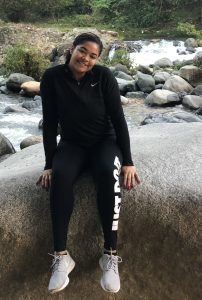 Semaj is a rising junior at the University of Maryland Eastern Shore in Princess Anne, Maryland and is pursuing a degree in Environmental Science with a concentration in Marine Science. She spent 2019 as a Mayoral Fellow with the City of Charleston, South Carolina where she worked as the lead researcher on a project for habitat restoration for FEMA buyout properties. Her career goals include continuing on to a law school and becoming an environmental lawyer. Semaj is working with Dr. Steve Lonhart at Monterey Bay National Marine Sanctuary and will be adding cnidarians (corals, anemones, and jellies) to the SIMoN Species Database. This online resource serves as a digital field guide for visitors to the sanctuaries along the west coast, providing natural history information about species that might be encountered by the public while walking along the beach, tidepooling, SCUBA diving, kayaking, sailing, or whale watching.
Semaj is a rising junior at the University of Maryland Eastern Shore in Princess Anne, Maryland and is pursuing a degree in Environmental Science with a concentration in Marine Science. She spent 2019 as a Mayoral Fellow with the City of Charleston, South Carolina where she worked as the lead researcher on a project for habitat restoration for FEMA buyout properties. Her career goals include continuing on to a law school and becoming an environmental lawyer. Semaj is working with Dr. Steve Lonhart at Monterey Bay National Marine Sanctuary and will be adding cnidarians (corals, anemones, and jellies) to the SIMoN Species Database. This online resource serves as a digital field guide for visitors to the sanctuaries along the west coast, providing natural history information about species that might be encountered by the public while walking along the beach, tidepooling, SCUBA diving, kayaking, sailing, or whale watching.
2020 Noah Jenkins, EPP Undergraduate Scholarship
Noah is a rising Junior at Humboldt State University where he is pursuing a degree in fisheries biology. Noah is from Sacramento, California and while growing up he always had a passion for fish, whether it was raising them in tanks or going into the wild and seeking them out. While living in the Central Valley his access to the ocean was limited but after moving to college (in close proximity to the ocean in Eureka, California) and participating in the Hollings Preparation Program, I have made it my personal goal to learn more about marine fishes and how they are affected by human interaction. This summer I am an EPP/MSI Scholar and working with Dr. Steve Lonhart to add multiple marine fish species to the SIMoN Species Database (an online field guide) that occur in NOAA sanctuaries off the coast of California. These data summaries will inform the public about marine fishes that occur in our west coast sanctuaries.
2020 Brynn Yarbrough, Ernest F. Hollings Undergraduate Scholarship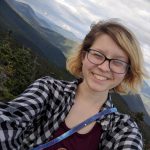
Brynn is an undergraduate at the University of Maine, Orono majoring in Marine Science with a concentration in Biology. She is very passionate about the West Coast Region’s Species Inventory project since it will serve as a foundation for multiple sanctuaries, and thus set the stage for a growing understanding of the species diversity of these protected areas and how it will change in the future. In the summer of 2020 working with Dr. Steve Lonhart, Brynn will use books and online resources to add to the existing Species Inventory, with the goal of expanding the inventory from Monterey Bay to include Greater Farallones, and even Olympic Coast NMS. Her career goals include continuing on to graduate school and becoming fluent in Japanese so she has the possibility of starting a marine science career in Japan, or to continue working with globally influential organizations such as NOAA.
2020 Victoria Zelinski, Ernest F. Hollings Undergraduate Scholarship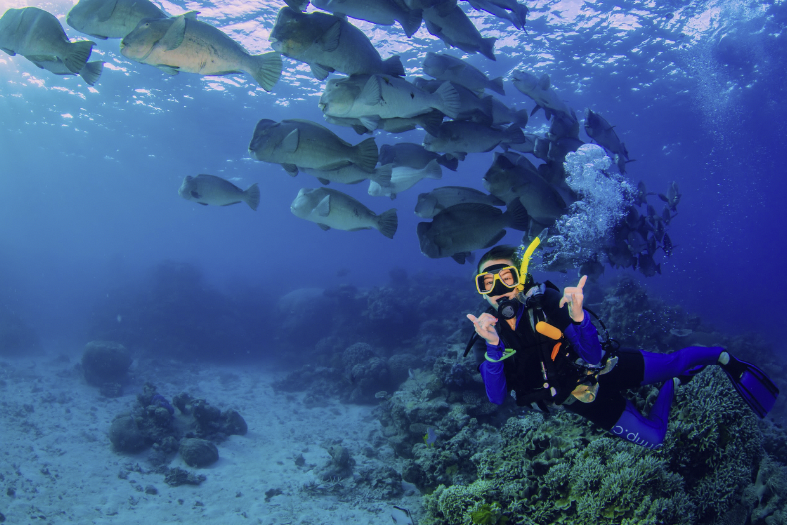
Victoria is a rising senior at the University of Miami studying marine science and biology with minors in marine policy, chemistry, and Spanish. During summer 2019, she worked with Channel Islands National Marine Sanctuary to expand the west coast species inventory project initiated at Monterey Bay National Marine Sanctuary. She worked with mentor Jackie Buhl to create first draft of a species inventory for CINMS, categorizing 3612 total species from 24 phyla, 55 classes, and 261 orders. Future Hollings scholars will continue to update and add to the CINMS inventory, as well as other sanctuaries, creating a network of inventories across the west coast. Upon graduation, Victoria hopes to attend graduate school and focus on bycatch and illegal, unreported, and unregulated (IUU) fishing reduction, marine conservation, and protection of vulnerable and endangered marine species.
2020 Alexandra Thomsen, NOAA CCME Graduate Scholar
M.S. Environmental Science, CSU Monterey Bay
B.A. Biology, Brown University
Alex completed her M.S. in Environmental Science as a NOAA Center for Marine & Coastal Ecosystems (CCME) Graduate Scholar at CSU Monterey Bay in 2020. For her Master’s research, she analyzed field-collected and remotely-sensed data to understand the spatial patterns of natural vegetation development at a tidal marsh restoration site in Elkhorn Slough, where Monterey Bay National Marine Sanctuary (MBNMS) and Elkhorn Slough National Estuarine Research Reserve (ESNERR) collaborate on research and management. This research is being used to inform adaptive management and planning of future tidal marsh restoration projects at ESNERR. During a 2019 summer internship, Alex was supervised by Dr. Steve Lonhart (MBNMS) and Dr. Kerstin Wasson (ESNERR) and evaluated methods for unmanned aircraft systems (UAS) data collection and image analysis for monitoring vegetation during marsh restoration. Prior to her Master’s, Alex completed her Bachelor’s degree in Biology at Brown University, worked for nonprofits on water quality and recreation (Charles River Conservancy) and conservation communications (The Ocean Project), and researched biological control of invasive aquatic and wetland weeds as a Technician at the USDA Agricultural Research Service. She is pursuing a career connecting research to policy and management to minimize tradeoffs between human needs and environmental protection.
2019 Hannah Brady, Ernest F. Hollings Undergraduate Scholarship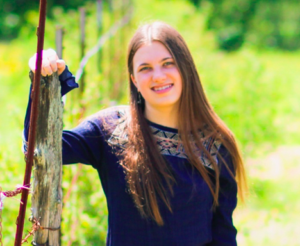
Hannah is going into her senior year at Texas A&M University – Corpus Christi as a Biology major with a concentration in Marine Biology. Hannah spent the 2019 summer working with Dr. Steve Lonhart, collecting 360° underwater photos and stitching them together to create images used in virtual reality for Monterey Bay. The goal of this project is to capitalize on growing public interest in virtual reality by using underwater photography to share a world most of the public never sees. The 360° underwater images are taken by a scuba diver using a fisheye camera on a tripod, and then the photos are stitched together using computer software to form a panoramic view. The completed panoramas were placed on the NOAA marine sanctuary website as the first virtual reality images available for Monterey Bay Sanctuary. These virtual maps are beneficial for educational purposes for scuba divers as well as the general public, offering a realistic view of the marine habitat. As a scientific diver, Hannah also took 360° images along the Monterey Bay Aquarium intake pipe that will be used for comparative purposes to demonstrate the effect of the future intake pipe restoration on the national marine sanctuary. Hannah plans to use the knowledge gained along with increased scuba diving experience to pursue her passion for the ocean and marine field research.
2019 Melia Matthews, Ernest F. Hollings Undergraduate Scholarship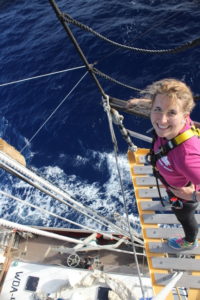
Melia Matthews is a senior at Whitman College in Walla Walla, Washington, majoring in Biology and minoring in Classics. She spent the 2019 summer working in the West Coast Regional Office of National Marine Sanctuaries in Monterey, CA. Her project continued ongoing work to design and populate a species inventory for Monterey Bay National Marine Sanctuary. One of the fundamental purposes of the sanctuary system is to maintain biological diversity within its waters, but currently no large marine protected area has a public inventory of the species that live within its boundaries. Working with mentors Bill Douros and Dr. Steve Lonhart, Melia compiled 2,500 species across 26 phyla. Plans are in the works for this project to be taken up by other west coast sanctuaries, and hopefully in the next few years, we will have a nation-wide network of sanctuary species inventories that will help scientists and policy makers understand and protect the immense biodiversity that our oceans have to offer.
Melia was very excited to have the opportunity to work in Monterey Bay, one of the nation’s foremost locations for marine research. Working here also gave Melia the opportunity to dive in cold water for the first time, become a certified NOAA diver, and develop her underwater photography skills. This internship helped Melia understand the possibilities of working in a marine biology field and helped her narrow down her choices for grad school. She is looking forward to continuing her education on the ocean and advancing her scientific diving career. 2020 update: Melia will be pursuing a PhD in Biomedical and Biological Sciences at Cornell in 2021.
2019 Miya Pavlock McAuliffe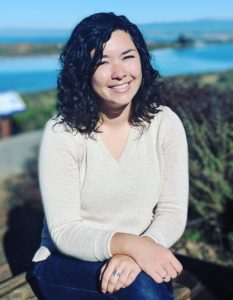 , NOAA CCME Graduate Scholar
, NOAA CCME Graduate Scholar
M.S. Marine Science, CSU Monterey Bay
B.S. Oceanography, U of Washington
Miya is a NOAA Center for Coastal and Marine Ecosystems Graduate Scholar working toward a Master of Science in Marine Science through California State University – Monterey Bay, at Moss Landing Marine Labs. Miya’s research falls at the intersection of physical and geological oceanography and is focused on assessing shoreline and sandbar response to varying wave events in the Monterey Bay. Miya earned her Bachelor of Science in Oceanography with a Minor in Arctic Policy and Research from the University of Washington and subsequently worked as a Data Technician automating oceanographic data analysis and processing methods before returning to graduate school. During her time at the Monterey Bay National Marine Sanctuary office, Miya worked with the Research Team to develop interactive online maps, process and analyze physical oceanography data, as well as streamline existing workflows. Miya strives to pursue a career that integrates data science, ocean and earth sciences, and making science accessible.
2019 Lauren Parker, NOAA CCME Graduate Scholar
M.S. Marine Science, CSU Monterey Bay
B.S. Aquatic Biology, UC Santa Barbara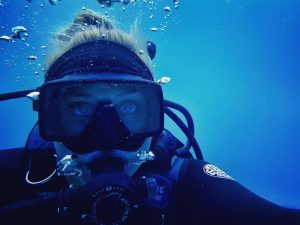
Lauren Parker is a NOAA CCME Graduate Scholar completing an M.S. in Marine Science at California State University, Monterey Bay and Moss Landing Marine Laboratories. Lauren is currently conducting research investigating the dynamics of mesophotic reefs on the central California coast under the supervision of Dr. James Lindholm and Dr. Scott Hamilton. Prior to joining the 2017 cohort of CCME scholars, Lauren graduated from the University of California, Santa Barbara with a B.S. in Aquatic Biology. She spent time working as a Research Technician for the Santa Barbara branch of the Partnership for Interdisciplinary Studies of Coastal Oceans (PISCO), surveying offshore oil platforms in the Santa Barbara Channel, and participating in a research cruise to conduct baseline surveys of the island archipelago of Tonga. In her time at the Monterey Bay National Marine Sanctuary office, Lauren worked with the Research Team, participating in review of the current Sanctuary Management Plan, SCUBA diving to take, stitch, and edit underwater images to create 360-degree virtual dives into sites within the MBNMS, and participated in a research cruise to Davidson Seamount on the E/V Nautilus. Lauren hopes to pursue a career that integrates ocean science, resource management, and science communication.
2018 Camisha Few, EPP Undergraduate Scholarship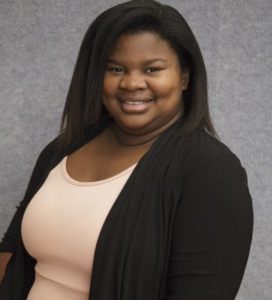
Camisha Few attends Florida A&M University where she is pursuing her bachelor’s degree in environmental science with a minor in journalism. “I hope to one day write for a science-oriented magazine or newsletter,” she said. “I’d also like to conduct my own research, inside and outside of the lab,” she said. “My goal is to just make a difference in the world and hopefully inspire the next generation to join in on the ever growing science field.” At Monterey Bay National Marine Sanctuary Camisha worked on an ongoing project to inventory the species that occur within the sanctuary with Dr. Steve Lonhart. She worked on the sea birds, a group that has hundreds of species that either live within or visit the sanctuary.
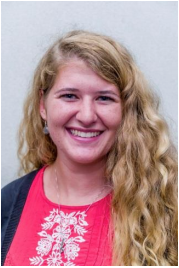
2017 Emily Colson, Ernest F. Hollings Undergraduate Scholarship
Emily is a rising senior at Eckerd College in St. Petersburg, Florida majoring in marine science, with a focus on marine biology, and minoring in psychology and chemistry. Emily spent her summer working with Dr. Steve Lonhart at NOAA’s Monterey Bay National Marine Sanctuary. The Sanctuary Integrated Monitoring Network (SIMoN) website has a speciesdatabase that provides natural history information on 170 species found in the sanctuary. The goal of this project was to expand the Species Database, and in particular add information about special status species (e.g., those listed as threatened or endangered under the Endangered Species Act). Emily completed over 70 entries that will be published on the Species Database website, which is currently being updated. Expanding the database increases valuable (and free!) knowledge about the species often observed by the public while visiting sanctuaries along the California coast.
Through her summer project, Emily was able to experience a new coast and learn about the species that are critical to the west coast environments. Emily also was able to follow her passion of educating the public about problems currently facing the world’s oceans.
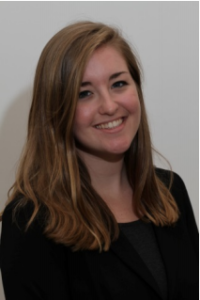
2016 Angela Korabik, Ernest F. Hollings Undergraduate Scholarship
Angie graduated from the University of South Carolina, Columbia, with a degree in ecology. Under the supervision of Dr. Steve Lonhart, she studied Undaria pinnatifida, a brown alga native to northeast Asia, that invaded Monterey Harbor in 2001. Undaria has become a problem across the world since the 1980s, having established in multiple locations, including the Mediterranean, Australia, New Zealand, Tasmania, and Argentina. In this project, we examined improved methods of removal that may reduce the time and effort required to manage the Undaria population of Monterey Harbor. We conducted an experiment in Monterey Harbor during the months of June and July (2016) to measure growth rates of Undaria individuals under two different treatments. Five sets of individuals from three age classes (young, juvenile, and mature) were cut either above or below the meristem, and were consequently measured twice a week for the duration of the experiment. Results show that Undaria growth is arrested in portions separated from the meristem, while portions with the meristem still intact are able to proceed to reproductive maturity. Additionally, data from removal efforts from 2002 to 2009 were analyzed to determine spatial trends in Undaria appearance. By assessing past trends in Undaria appearances and analyzing the best way to remove Undaria, future removal efforts can be streamlined and accelerated to maintain low densities in Monterey harbor, protect existing microhabitats in the harbor, and possibly slow the rate of spread beyond the harbor. 2020 update: Angela is currently a PhD student in biology at UC Davis.
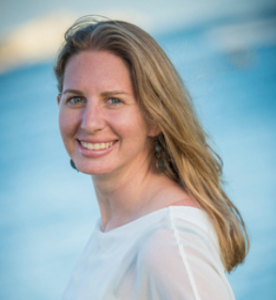
2014 Nyssa Silbiger, Ph.D., Dr. Nancy Foster Scholarship
Dr. Nyssa Silbiger completed her B.S. in Biology at Florida State University, her M.S. in Marine Science at the University of North Carolina at Chapel Hill, and her PhD in Zoology at the University of Hawai‘i at Mānoa (2015). During her tenure as a Nancy Foster Scholar she worked in the Papahānaumokuākea Marine National Monument and other sites throughout the Hawaiian Islands to characterize accretion and erosion on coral reefs and examine how these processes are modulated by climate change in the context of both natural variability and simulated future conditions. Nyssa also had the opportunity to collaborate with Dr. Steve Lonhart at the Monterey Bay National Marine Sanctuary office during her tenure as a Foster Scholar. Nyssa is currently ann Assistant Professor in the Biology Department at California State University, Northridge. 2020 update: Dr. Silbiger is currently an Assistant Professor of Biology at CSU Northridge.
Sea Grant Fellows
The California Sea Grant Fellowship program is an education opportunity for graduate students interested in marine resources and how they are managed in California. Modeled after the Knauss Marine Policy Fellowship Program, the Fellowship program provides an opportunity to acquire on-the-job experience in the implementation of marine and coastal resource policies and programs in the state of California. Recent graduates with a Masters or PhD are matched with a host Federal or State agency for a 12-month paid fellowship.
The Monterey Bay National Marine Sanctuary has participated in this program for several years, and its Fellows have gone on to pursue careers in federal and state governments, consulting and education. This web page provides a history of the sanctuary’s past Fellows, their educational background, examples of projects they completed while at the sanctuary and the jobs they pursued after their Fellowship. California Sea Grant is a statewide, multi-university program of marine research, extension and education services, administered by the University of California and headquartered at the Scripps Institution of Oceanography. The National Sea Grant College Program is part of the National Oceanic and Atmospheric Administration, U.S. Department of Commerce. For more information about the California Sea Grant Fellowship you can visit the Sea Grant webpage here.
Libby Mohn
2024 Sea Grant Fellow
Master of International Environmental Policy, Middlebury Institute of International Studies
B.A. History, Wake Forest University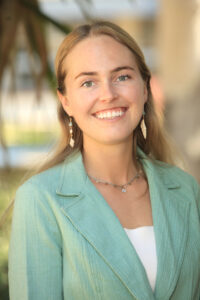
Libby will be working with the MBNMS Research Team and Resource Protection Team on two different priority items. First, she will be implementing the sanctuary’s Iconic Kelp Plan by coordinating working groups, facilitating group meetings, and assisting with the development of a Kelp Action Plan to inform the MBNMS Management Plan. Afterward, she will be working on developing the MBNMS Climate Adaptation Plan. Along with priority projects, Libby will be involved in other sanctuary efforts, such as boat operations, outreach, and building relationships with Indigenous tribes.
Libby earned a Bachelor of Arts degree in History with minors in International Relations, Biology, and Environmental Studies from Wake Forest, and a Masters in International Environmental Policy from the Middlebury Institute of International Studies. Her experience includes working with the IUCN WCPA on area-based management tools related to the BBNJ Treaty (United Nations Biodiversity of Areas Beyond National Jurisdiction Treaty) and conducting research on high seas MPA implementation under this Treaty.
Grace Kumaishi
2023 Sea Grant Fellow
Master of Environmental Science and Management, UC Santa Barbara
B.S. Ecology, Behavior, and Evolution, UCLA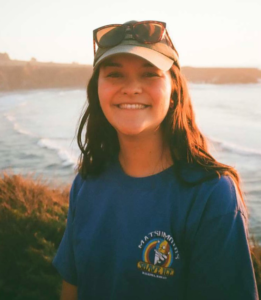
Grace joined the MBNMS Research Team to assist with the implementation of research and resource protection strategies highlighted in the MBNMS 5 year priority plan. Her projects will include (1) co-authoring climate vulnerability assessments for Monterey Bay and Channel Islands national marine sanctuaries, and (2) developing a phone app to connect scientists and resource managers within the sanctuary. Grace will participate in supporting other climate science, education, and operational efforts as needed.
Grace earned a Bachelor of Science in Ecology, Behavior, and Evolution from UCLA, and a Master of Environmental Science and Management from the Bren School at UC Santa Barbara. Her professional experience includes laboratory and field research focused on zooplankton composition, marine predator diet, and breeding seabird ecology. Grace’s graduate work focused on data analysis and geospatial modeling of human wildlife conflict in the face of global climate change with NGO partners including The Nature Conservancy and Conservation International.
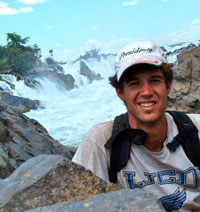
Oren Frey
2011 Sea Grant Fellow
M.A. International Environmental Policy from the Monterey Institute of International Studies
B.A. Environmental Studies with a specialization in Human Ecology, Middlebury College
Oren works closely with the MBNMS Research Team on a number of projects, including: a threats assessment for Davidson Seamount; authored a report on the phenomenon of shipping container loss; participated in at-sea deepwater characterization research; organized a collaborative fisheries research study on the hook and line fishery for California halibut in Monterey Bay; and is working to advance the creation of a community supported fishery (CSF) for the Monterey Bay area.
Oren earned a Bachelor of Arts degree in Environmental Studies with a specialization in Human Ecology from Middlebury College, and a Master of Arts degree in International Environmental Policy from the Monterey Institute of International Studies. His experience includes managing a marine education program for Naturalists at Large on Catalina Island. He has conducted research in the fields of ethnography, international environmental policy, and environmental economics.
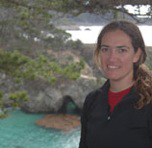
Kristine Faloon
2010 Sea Grant Fellow
Master of Environmental Science and Management, UC Santa Barbara
B.A. Biology with concentration in marine science, Boston University
Kristine worked on Monterey Bay National Marine Sanctuary (MBNMS) fish habitat materials; the Sanctuary Characterization and Image Display SCID interface for the Pacific Grove Natural History Museum Exhibit entitled ‘World of Fishes’; field operations for shelf characterization and lost fishing gear cruises; authored content for Ocean Acidification and Sporadic Events on the SIMoN web site; and provided SCUBA support after NOAA Science Diver Certification.
Kristine completed her Fellowship in the summer of 2010 and was hired as a Marine Science and Oceanography instructor for Sea | Mester, a global semester at sea program for college students.
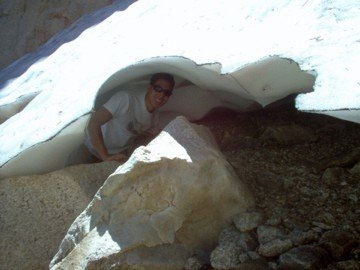
Steve Choy
2009 Sea Grant Fellow
Master of Environmental Science and Management, UC Santa Barbara
B.S. in Biology, University of Illinois at Urbana-Champaign
Steve organized the poster session for the 2009 Sanctuary Currents Symposium; investigated the effects of thermal discharge from Moss Landing Power Plant; studied the removal of the invasive Asian kelp Undaria pinnatifida from Monterey Harbor; and developed a web-based historical ecology timeline of marine resources within MBNMS.
Steve completed his Fellowship in the winter of 2009 and is a Fish and Wildlife Scientific Aid with the California Department of Fish and Game.
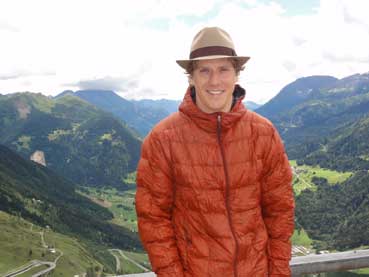
Hugo Selbie
2008 Sea Grant Fellow
Master of Marine Biodiversity and Conservation, Scripps Institution of Oceanography
B.S. in Marine Geography, Cardiff University, Wales, UK
Hugo sourced and compiled marine historical ecology data for MBNMS; created the first MBNMS marine historical ecology database; authored a technical report entitled ‘Phase I: Historical Sources Survey Report’ organized the 2008 Sanctuary Currents Symposium (>300 attendees); and contributed articles to the Sporadic Events Section of the SIMoN web site.
Hugo left MBNMS and became a Policy and Outreach Coordinator for the Partnership for Interdisciplinary Studies of Coastal Oceans (PISCO) (http://www.piscoweb.org) at the University of California, Santa Cruz. He is also a data analyst at NOAA’s National Marine Protected Areas Center in Monterey, working as a contractor on the agency’s ambitious MPA Inventory project, an effort to catalog and describe the nation’s network of marine protected areas.
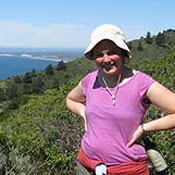
Amber Szoboszlai
2007 Sea Grant Fellow
M.S. in Biology, Moss Landing Marine Laboratories
B.A. in Liberal Arts, Hampshire College
Amber studied the role of facilitation in rocky intertidal seaweed communities while at MLML. This work highlighted how species interactions and species diversity can influence patterns of distribution of early life history stages of seaweeds.
At MBNMS, Amber conducted an evaluation of the Sanctuary Integrated Monitoring (SIMoN) Program and a compilation of black abalone data for an endangered species evaluation.
Amber received a PhD in Ecology at UC Davis. While working as a marine science policy fellow at the Monterey Bay Marine Sanctuary, she discovered my ambition to conduct research that can be integrated with marine policy and management. For her dissertation she is working to develop an integrated perspective of interactions between oyster aquaculture practices and eelgrass populations. Scientists currently have a poor understanding of how combined positive and negative effects of oyster aquaculture relate to eelgrass persistence and survival. By exploring how eelgrass responds to oyster aquaculture, her research will help to develop eelgrass sustainability guidelines for aquaculture businesses and to manage future expansion of aquaculture facilities. 2020 update: Dr. Szoboszlai has been a Research Scientist at the Farallon Institute since 2012.
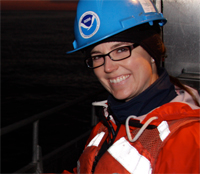
Lorraine Anglin
2006 Sea Grant Fellow
Master of Advanced Studies in Marine Biodiversity and Conservation, UC San Diego
B.A. in Biology, Willamette University
Lorraine developed towed camera sled data collection protocols, including associated hardware and software requirements, for long-term monitoring inside and outside of state Marine Protected Areas. She was also intimately involved with boating operations, particularly once the R/V FULMAR arrived to the West Coast Region.
After her Fellowship, Lorraine continued as a Field Operations Coordinator for the West Coast Region in the Office of National Marine Sanctuaries. The West Coast Regional office manages 12,682 square miles of marine protected areas around the Channel Islands, Cordell Bank, Greater Farallones, Monterey Bay and Olympic Coast. Each of the five west coast national marine sanctuaries is intimately connected not only with the others, but also to the entire coast from Alaska to Baja and to the far reaches of the world ocean via ocean currents. Lorraine serves as the Vessel Operations Coordinator, which includes the R/V FULMAR and R/V 4107, and also works with scheduling the NOAA Twin Otter airplane.
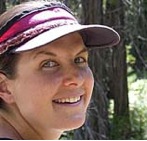
Becky (Stamski) MacKnight
2005 Sea Grant Fellow
M.S. in Earth Science, UC Santa Cruz
B.A. in Geology, Amherst College
Becky developed materials for the Coastal Erosion and Armoring Action Plan as part of the Management Plan Review process for MBNMS; created GIS-based analysis tools for water quality monitoring associated with the Elkhorn Slough; wrote and edited SIMoN website content, particularly for the geology sections; published a NOAA Marine Sanctuaries Conservation Series report on coastal protection structures in the MBNMS: http://sanctuaries.noaa.gov/special/con_coast/stamski.pdf.
Becky is a geologist, and is currently an Environmental Scientist at the Horsley Witten Group, an environmental science, engineering, and planning company in Massachusetts.
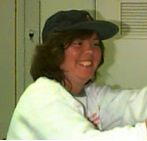
Michele Jacobi
1997 Sea Grant Fellow
M.S. in Marine Science, Moss Landing Marine Laboratories
B.S. in Biology and Marine Science, University of San Diego
Michele wrote an assessment of the impacts of anthropogenic sound in the ocean and improved the MBNMS web site.
Michele is now an environmental scientist for the National Oceanic and Atmospheric Administration (NOAA) Office of Response and Restoration (OR&R) in Seattle, WA. As part of the Technical Support Division she has experience regarding eco-risk assessment reviews, chemical data analysis, field sampling design, and the development of watershed database and GIS mapping projects. Michele is currently on assignment to the Coastal Response Research Center and is applying the concept of a watershed database and mapping project towards emergency planning and response for the Portsmouth Harbor Area.
Students & Interns
SIMoN staff members are often asked to advise undergraduate capstone and senior theses, to supervise funded summer internships, and to serve as external members on graduate thesis and dissertation committees. In addition, some graduate students sought guidance from and collaborated with SIMoN staff while conducting their research within the sanctuary. Below are some of these undergraduate and graduate students (and the staff advisor, as applicable).
In progress. Gregory Bongey, MS student, MLML. (Lonhart on thesis committee)
2017 Devona Yates, MS, MLML. “Spatial variation of invertebrate survival in central California kelp forests.” (Lonhart on thesis committee)
2017 Heidi Heigl, post-BS from Ludwig-Maximilians-Universität München. Summer volunteer internship. (Lonhart advisor)
2017 Olivia Rhoades, Ph.D., UC Davis. “Causes and consequences of behavioral trait variation for marine community dynamics.” (Lonhart research collaborator)
2016 Stephen Loiacono, MS, MLML. “Effects of substrate warming on sessile marine invertebrate communities in Monterey Bay, California.” (Lonhart on thesis committee)
2015 Kent Susick, CSU Council on Ocean Affairs, Science & Technology (COAST), SJSU. “Sanctuary Ecologically Significant Areas (SESAs) Quick Look Reports.” (DeVogelaere advisor)
2014 Emily Aiken, Senior Capstone, Marine Science, CSUMB. “How the native crab (Metacarcinus gracilis) affects the spread of the invasive bryozoan (Watersipora subtorquata).” (Lonhart on capstone committee)
2012-14 Oren Frey, Research Intern, MBNMS. “Site Damage Assessment: Sunken F/V Stikine“; “A Profile of the Hook and Line Fishery for California Halibut in Monterey Bay, California: Learning from Fishermen through Collaborative Research”; “A Review of Resource Management Strategies for Protection of Seamounts”; “Deep-sea Faunal Communities Associated with a Lost Intermodal Shipping Container in the Monterey Bay National Marine Sanctuary, CA”; and “The Containerized Shipping Industry and the Phenomenon of Containers Lost at Sea.” (DeVogelaere research collaborator and advisor)
2012 Brynn Hooton-Kaufman, MS, MLML.”Associations between fishes and the invasive kelp Undaria pinnatifida in Monterey Harbor, Monterey, CA.” (Lonhart on thesis committee)
2012 Ashley Knight, MS, CSUMB. “The distribution of demersal fishes over heterogenous seafloor habitats: an application of landscape ecology to video imagery collected in a central California state marine conservation area.” (DeVogelaere on thesis committee)
2011 Shae Mitchell, MS, CSUMB. “Lottia gigantea size and density differences in rocky intertidal communities near Monterey Bay, California.” (Lonhart on thesis committee)
2011 Megan Gunvalson, MS, SJSU. “Reducing disturbances to marine mammals by kayakers in the Monterey Bay.” (Lonhart on thesis committee)
2010 Ryan Rezek, MA, Scripps. “Investigation of the invasive kelp Undaria pinnatifida: dispersal mechanisms and methods for controlling zoospores.” (Lonhart on thesis committee)
2010 Sarah Traiger, Senior Thesis, UCSC. “Community effects of an invasive bryozoan, Watersipora subtorquata, in the Monterey harbor.” (Lonhart research collaborator)
2009 Adam Curtis, Senior Capstone, ESSP, CSUMB. “Monterey Bay kelp forests: full of diversity!” (Lonhart advisor)
2009 Kayleigh Hughes, MS, Bangor University. “A survey of the rocky intertidal at Point Pinos, California. Part I: A temporal study, separating anthropogenic factors from natural fluctuations.” (Lonhart research collaborator)
2008 Gabriel Rodriguez, Senior Capstone, ESSP, CSUMB. “Growth rates and disturbance response of the invasive kelp, Undaria pinnatifida in Monterey Harbor, CA.” (Lonhart on capstone committee)
2007 Diana Kohtio, MS, MLML. “Population biology of the invasive kelp Undaria pinnatifida in central California.” (Lonhart on thesis committee)
Support SIMoN
Financial Support
The SIMoN program is funded by numerous sources. Federal and state government agencies have seen the value of its initiatives and provided program-specific funding. Individuals, corporations, and private foundations are also important SIMoN supporters.
There are many donor options available with the California Marine Sanctuary Foundation and the SIMoN program. In general, donations are either targeted toward general operating expenses or toward a specific program. In some instances, a donor identifies a need and the Foundation creates and implements a program to address it. In other cases, a donor or group of donors contribute to a restricted fund, targeted for a specific program.
